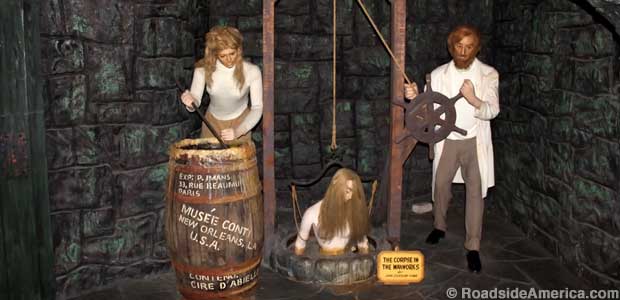
In the Musee Conti dungeon, trained professionals turn a fresh corpse into a lifelike wax figure.
Musee Conti: Wax Museum of New Orleans (Closed)
New Orleans, Louisiana
If you ever wake up in a wax museum next to a Cyclops in a cage, Napoleon in a bathtub, and two prostitutes cat-fighting on a street, you may be in deep trouble, but you're not lost. It's the Musee Conti (French for "Museum on Conti Street"), a wax museum like no other because it's devoted almost exclusively to one subject: New Orleans.
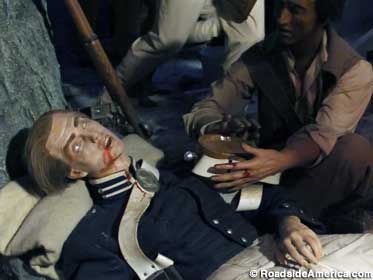
On the wrong end of a bullet at the Battle of New Orleans.
It began in the early 1960s, when local hotel owner Benjamin Weil and theater owner Isador Lazarus toured Madame Tussauds in London. They decided that New Orleans needed a similar wax museum to tell its story. They hired a mannequin manufacturer in Paris, spent three years and the equivalent of over $5 million in today's dollars, and opened Musee Conti in 1964.
Publicity at the time touted the no-expenses-spared nature of the museum. The wax dummies reportedly flew to New Orleans on Pan Am, some in passenger seats. It was said that all of the man-mannequins were given real beards, inserted hair by hair, then clean-shaven (mostly) to give them realistic five o'clock shadows.
Musee Conti today is almost exactly as it was when it opened over 50 years ago, with just a handful of later additions. It's the opposite of most modern wax museums, which constantly add new celebrities in the belief that new celebrities are what people want to see. Musee Conti believes otherwise. Nearly all of the 147 people enshrined in it are dead.
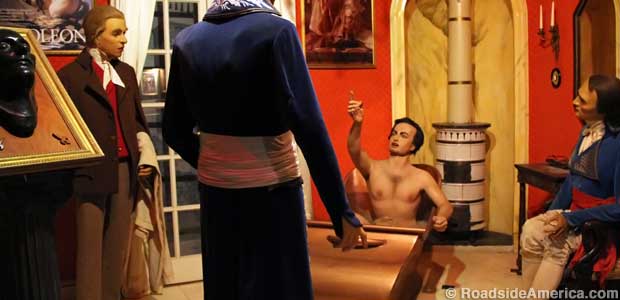
Tub Time for Napoleon: he scolds his brothers, then sells Louisiana to America.
The museum focuses on real New Orleans history, not fiction. There are no tributes to Interview with the Vampire, or A Confederacy of Dunces, or even A Streetcar Named Desire. Instead, the 22,000-square-foot building features lurid tableaux of whores and gamblers, jazz and voodoo. Many of the places depicted in the museum are just outside its front door: the death-dueling alley, the Voodoo Queen's home, the Slave Market and torture house, the "Casket Girls" convent, the prostitutes' battleground, the sites of the 1768 massacre of Frenchmen and the 1891 massacre of Italians. The museum points this out at every opportunity.
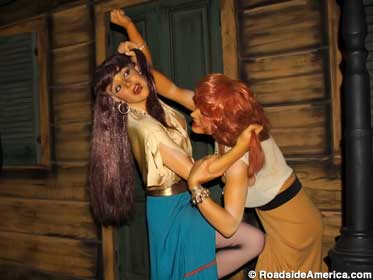
Streetwalkers settle their differences in New Orleans' red light district.
Napoleon in his bathtub has always been a highlight, capturing the moment when the enraged Frenchman defied his brothers by selling Louisiana to the Americans. An exhibit sign asserts that Napoleon in fact stood up and threw water on his siblings. The museum did not show this, the sign explains, because the dummy brothers' costumes were too expensive to damage. "For obvious reasons," reads the sign, Napoleon remains seated, a modesty sponge shielding his private parts.
In the cat fight diorama, two fallen ladies of Storyville, a notorious district only a couple of blocks from the museum, tear at each others' clothes and hair for no apparent reason, suggesting that similar battles happened so often that it wasn't worth explaining. "Whiskey, women, and frequently even life were cheap," reads an accompanying sign. A third hooker embraces a man while simultaneously stealing his wallet.
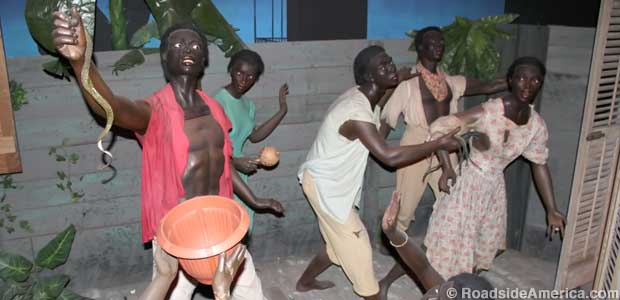
Torn Dress Girl wants nothing to do with Mr. Voodoo Snake.
Historical obscurities are Musee Conti's specialty. One diorama explains how the gambling game of "craps" was born in New Orleans. Another gives an unflattering portrait of Benjamin "Spoons" Butler, rascally Union Army boss of the city, who got his nickname "because he 'liberated' so much of their silverware." The forgotten Italian massacre of 1891 was "one of the largest mass lynchings in American history" and "almost resulted in declarations of war between the United States and the government of Italy." The beautiful Madame Delphine Lalaurie gave dinner parties that "were the toast of society" until it was discovered that she was simultaneously torturing enslaved people in her attic, apparently for fun.
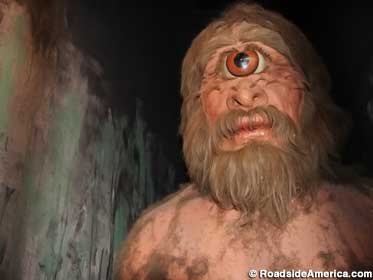
Giant, hairy monster keeps an eye on the exit door at Musee Conti.
Adding to the strangeness of Muse Conti is its "Haunted Dungeon," an appendix that has nothing to do with New Orleans but much to do with copying Madame Tussauds successful formula. Here the museum again goes Old School by favoring 19th century gothic horror: The Body Snatcher, The Murders in Rue Morgue, The Corpse in the Waxworks. This last tableaux shows two Musee Conti employees dipping the body of a dead young woman into a barrel of liquid beeswax shipped from the museum's dummy-maker in Paris.
And the caged Cyclops? It's the final exhibit, explained as an example of the New Orleans' custom of lagniappe, "a little something extra," reads an accompanying sign, "bestowed upon customers in appreciation for their trade. You'll have to admit this gigantic, one-eyed, man-eating Cyclops is something extra!"
When Katrina slammed into New Orleans in 2005, the owners locked Musee Conti and fled. Trapped in a windowless building for three weeks of 100 degree heat with no air conditioning, the dummies were not expected to survive. But when the owners returned they found -- not pools of beeswax -- but all the dummies intact and standing, although somewhat "sweaty." They've been left as they were, some with noses slightly diminished, some with faces slightly streaked, some with visible wax stains on their clothes. Just another example of New Orleans history, preserved for the public by Musee Conti -- and reassuring proof that despite their lifelike qualities, none of the dummies are people dipped in wax.





